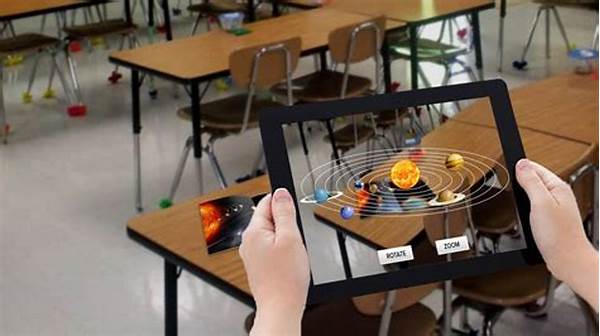The Role of Augmented Reality in Education
Augmented reality in education represents a transformative approach to teaching and learning, leveraging technology to enhance student engagement and comprehension. This innovative approach integrates digital information with the traditional classroom environment, providing immersive learning experiences that can be tailored to various subjects and learning styles. By combining real-world elements with virtual content, educators can create interactive lessons that capture students’ imaginations and promote deeper understanding. As educational institutions strive to address diverse learning needs and adapt to technological advancements, augmented reality offers a promising solution that enriches curriculum delivery and bridges the gap between theoretical concepts and practical application.
Read Now : Exploring Acting Skills In Youth
The implementation of augmented reality in education facilitates active participation and exploration, encouraging students to engage with learning materials in dynamic ways. For example, in science classes, students can visualize complex molecular structures or witness virtual dissections, enhancing their grasp of abstract concepts. Similarly, in history lessons, learners can take virtual tours of ancient civilizations or interact with historical figures, fostering a more profound connection with the subject matter. By accommodating different learning preferences and making abstract concepts tangible, augmented reality fosters an inclusive and engaging educational environment.
Moreover, augmented reality in education has the capacity to break down geographical barriers, connecting students and educators from around the world. With virtual field trips and global collaborative projects, students gain exposure to diverse cultures and perspectives, broadening their horizons and preparing them for an interconnected world. By embracing augmented reality, educators can foster curiosity, critical thinking, and collaboration, equipping students with essential skills for the future. As the technology continues to evolve, its integration into educational frameworks will likely deepen, shaping the future of teaching and learning in unprecedented ways.
Benefits of Augmented Reality in Education
1. Enhances Engagement: Augmented reality in education captivates students by providing interactive and visually stimulating content, significantly increasing their motivation to learn and explore various topics.
2. Personalized Learning: AR allows for differentiation in instruction, enabling educators to tailor lessons to individual learning styles and paces, thus ensuring that all students achieve optimal understanding.
3. Facilitates Complex Concepts: With augmented reality, challenging subjects like mathematics and science become more accessible, as abstract ideas are visualized in a concrete manner, aiding comprehension.
4. Real-World Application: AR promotes the practical application of theoretical knowledge, allowing students to simulate real-world scenarios and experiment in a safe, controlled environment.
5. Supports Remote Learning: Augmented reality in education provides opportunities for immersive distance learning experiences, bridging the gap between learners and educational content regardless of their physical location.
Challenges and Considerations for Augmented Reality in Education
Despite the numerous advantages of augmented reality in education, there are several challenges that educators and institutions must address to ensure effective implementation. One significant consideration is the cost associated with acquiring and maintaining the necessary technology. Educational institutions may face budget constraints that limit their ability to invest in AR tools and infrastructure. Additionally, there is a learning curve involved for both teachers and students, as they need to become familiar with new technologies and adapt their traditional teaching methodologies to incorporate AR effectively.
Read Now : Encouraging Participation In Weekend Courses
Another challenge lies in developing high-quality content that aligns with existing curricula and educational standards. It is crucial to ensure that augmented reality applications are not only engaging but also pedagogically sound, providing value to the learning process. Collaboration between educators, technology developers, and content specialists is essential to create meaningful and effective AR educational experiences. Furthermore, educators must consider issues related to accessibility, ensuring that all students, regardless of socioeconomic background or physical ability, have equitable access to AR-enhanced learning.
Applications of Augmented Reality in Education
Chemistry and Biology
Augmented reality in education has revolutionized the teaching of complex scientific subjects such as chemistry and biology. Through AR, students can engage in virtual experiments and visualizations that augment their understanding of molecular structures and biological processes. For instance, AR applications allow students to manipulate 3D models of molecules, facilitating a hands-on experience that traditional textbooks cannot provide. This interactive approach not only deepens comprehension but also stimulates scientific curiosity, encouraging students to explore and inquire further into the scientific world.
History and Social Studies
In the realm of history and social studies, augmented reality in education creates opportunities for students to experience historical events and cultural landmarks firsthand. By overlaying historical data on real-world environments, students can embark on virtual field trips to historical sites or interact with digital recreations of historical figures. This immersive experience allows students to develop a more profound appreciation and understanding of historical contexts and cultural developments. Augmented reality breathes life into historical narratives, transforming them from static stories into captivating, interactive journeys.
Conclusion: The Future of Augmented Reality in Education
As we look to the future, augmented reality in education holds the potential to redefine traditional learning paradigms by integrating cutting-edge technology with educational content. By fostering an engaging, interactive, and personalized learning environment, AR empowers educators to captivate students’ imaginations and cultivate a lifelong passion for learning. However, for augmented reality to realize its full potential, it is imperative that educators, technologists, and policymakers collaborate to address challenges related to cost, accessibility, and content development.
In conclusion, augmented reality in education is poised to transform the educational landscape by providing innovative solutions to enhance engagement and understanding. As the technology continues to evolve, educators must remain adaptable and open to integrating new tools into their teaching strategies. By embracing the potential of augmented reality, educational institutions can prepare students for an increasingly digital and interconnected world, equipping them with the skills and knowledge needed to thrive in an ever-changing global society.
